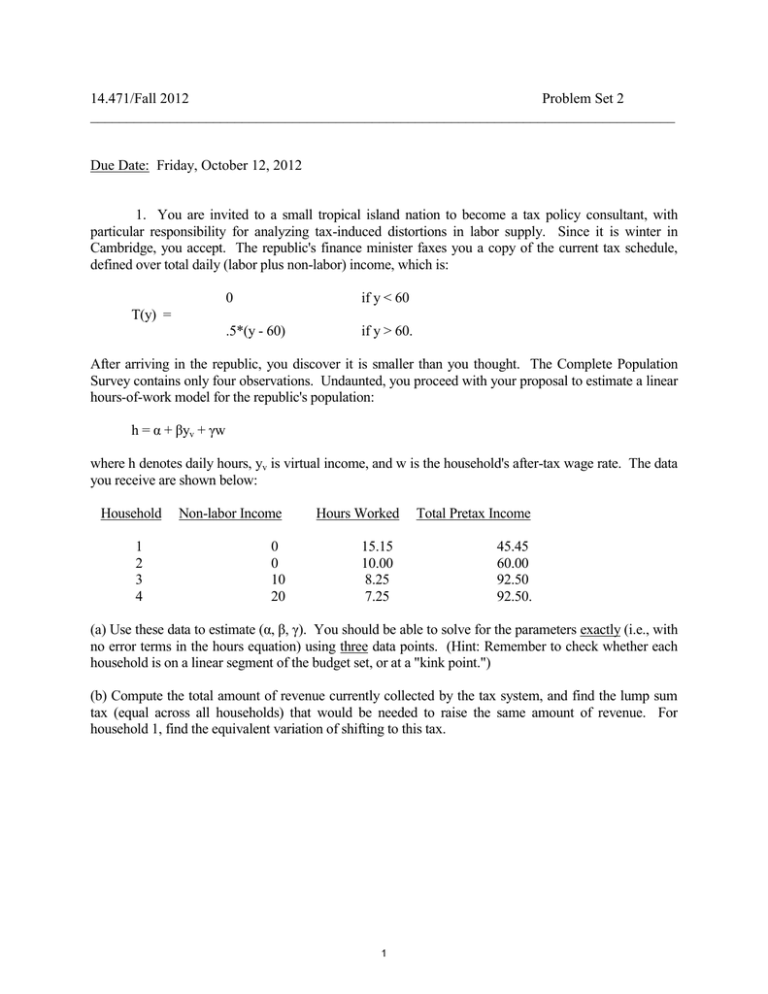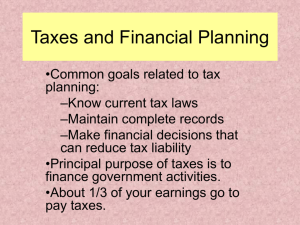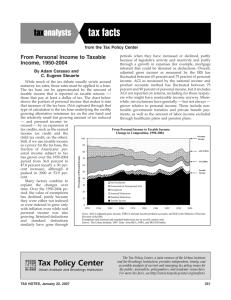14.471/Fall 2012 Problem Set 2 _________________________________________________________________________________
advertisement

14.471/Fall 2012 Problem Set 2 _________________________________________________________________________________ Due Date: Friday, October 12, 2012 1. You are invited to a small tropical island nation to become a tax policy consultant, with particular responsibility for analyzing tax-induced distortions in labor supply. Since it is winter in Cambridge, you accept. The republic's finance minister faxes you a copy of the current tax schedule, defined over total daily (labor plus non-labor) income, which is: T(y) = 0 if y < 60 .5*(y - 60) if y > 60. After arriving in the republic, you discover it is smaller than you thought. The Complete Population Survey contains only four observations. Undaunted, you proceed with your proposal to estimate a linear hours-of-work model for the republic's population: h = α + βyv + γw where h denotes daily hours, yv is virtual income, and w is the household's after-tax wage rate. The data you receive are shown below: Household 1 2 3 4 Non-labor Income 0 0 10 20 Hours Worked 15.15 10.00 8.25 7.25 Total Pretax Income 45.45 60.00 92.50 92.50. (a) Use these data to estimate (α, β, γ). You should be able to solve for the parameters exactly (i.e., with no error terms in the hours equation) using three data points. (Hint: Remember to check whether each household is on a linear segment of the budget set, or at a "kink point.") (b) Compute the total amount of revenue currently collected by the tax system, and find the lump sum tax (equal across all households) that would be needed to raise the same amount of revenue. For household 1, find the equivalent variation of shifting to this tax. 1 2. The next summer, you are invited by the government of a small state in one of the large South American nations to help in designing a tax reform. Eager for a some Andean skiing, you accept. Upon arrival, you discover that the economy consists of two types of individuals, with each type accounting for half of the population. Jello is the numeraire consumption good in the economy. The first type of individual has a wage of 1 jello packet per unit of labor supplied, and the second has a wage of 2 jello packets per unit of labor. Individuals of each type have an endowment of one unit of labor. Each individual also has a lump sum income of one packet of jello. Individuals of both types have preferences over three goods: leisure (1-L), jello (J), and coconuts (C). These preferences are described by a utility function: U = log J + log C + log (1-L). There is a domestic production technology that turns one package of jello into one unit of a general consumption good. The process can be reversed. The current tax system is as follows. Taxable income, which is measured in units of jello, is defined as labor earnings plus lump sum income. The marginal tax rate on the first 1.5 jellos of income is 25 percent, while the marginal tax rate is 50 percent on all income above this level. (a) You begin your analysis of the tax system by trying to determine the optimal labor supply behavior of the two types of individuals in this economy. Find the labor supply, consumption of jello, and consumption of coconuts for individuals with a wage of 1, and for those with a wage of 2. (b) What is per capita tax revenue from the current tax code? (c) The domestic retail lobby has proposed a tax deduction for purchases of the general consumption good. If all expenditures on this good were excluded from taxable income, describe the new tax schedule. How would per capita revenue change if this policy were adopted? Explain the factors that contribute to any revenue change that you identify. (d) The retail lobby has evaluated the potential revenue cost of the proposal in (c) by multiplying outlays on the general consumption good under the current (no deduction) tax system by estimates of marginal tax rates for consumers of types 1 and 2. (This is known as "static revenue estimation.") Do your calculations offer any insights on the validity or limitations of this approach? 2 3. The following table provides data on the number of single tax filers in various Adjusted Gross Income (AGI ) categories for 2008 in the United States (the data are based on actual U.S. data with some interpolation). These data are also available in a STATA dataset (.dta file) on the course’s website . The data table excludes tax returns with AGI of less than $5000 and of more than $100,000. Adjusted Gross Income (AGI) Level (000s) 5-10 10-15 15-20 20-25 25-30 30-35 35-40 40-45 45-50 50-55 55-60 60-65 65-70 70-75 75-80 80-85 85-90 90-95 95-100 Number of Returns (millions) 8.853 6.913 5.973 4.906 4.306 3.450 3.521 2.700 2.172 1.500 1.350 1.300 1.150 0.936 0.800 0.650 0.375 0.240 0.157 The 2008 personal income tax schedule for single individuals applies a 10% tax rate when taxable is below $8025, a 15% marginal rate on taxable income between $8025 and $32,550, 25% for taxable income between $32550 and $78850, and 28% for taxable income above $78850. To convert AGI to taxable income, assume that all single taxpayers claim a standard deduction of $5450, and one dependent allowance of $3500, so Taxable Income = AGI - 8950. (a) Using STATA or another package of your choice, estimate a quadratic relating the number of returns in each income "bin" to the first three powers of AGI at the midpoint of the bin. Then add an indicator variable for the bin (or bins) in which you might expect to see "bunching" of taxpayers. Draw a diagram of the budget that corresponds to the tax rate schedule and graphically or otherwise explain your rationale for searching for particular bunching patterns. Can you reject the null hypothesis of "no bunching"? How do your results change if you use a third-order polynomial to fit the income distribution? (b) What difficulties do you encounter in trying to assess the degree of bunching using aggregate cell data such as that in this table? Under what conditions might aggregate data of this form be reasonably helpful in testing for bunching? 3 4. Consider an individual with preferences over consumption in two periods given by: V(C1, C2) = log C1 + [1/(1+δ)] log C2. This individual faces a wage income tax, so that the interest rate at which she can borrow and lend is simply r. Assume that her wage income in periods 1 and 2 is fixed at Y1 and Y2, and that her labor income tax rate in period 1 is 1 while that in period 2 is 2. Assume that 1 > 2, and that both taxes are linear. Further assume that the individual has access to a “tax avoidance technology” that permits wage income to be shifted from period 1 to period 2. If the individual chooses to shift A dollars from period 1 to period 2, where A is between 0 and Y1, her taxable income in period 1 will be Y1 – A and that in period 2 will be Y2 + A. Using the tax avoidance technology is costly; the cost of shifting A dollars is (A). This cost can be viewed as the legal and administrative fees associated with tax avoidance, and it must be paid in period 1. (a) Find the lifetime budget constraint for this individual, recognizing both the impact of tax avoidance on income net of taxes, and the cost of tax avoidance. (b) Now obtain first order conditions for the optimal choice of A. Does the optimal level of A depend on the utility function? Explain why or why not. (c) Consider the case in which (A) = A2, and assume that r = 0. Obtain a formula for A as a function of the tax rates in the two periods, and compute the elasticity of tax avoidance (A) with respect to (1-1). Briefly describe the implications for the impact of tax changes on revenue. 4 MIT OpenCourseWare http://ocw.mit.edu 14.471 Public Economics I Fall 2012 For information about citing these materials or our Terms of Use, visit: http://ocw.mit.edu/terms.






